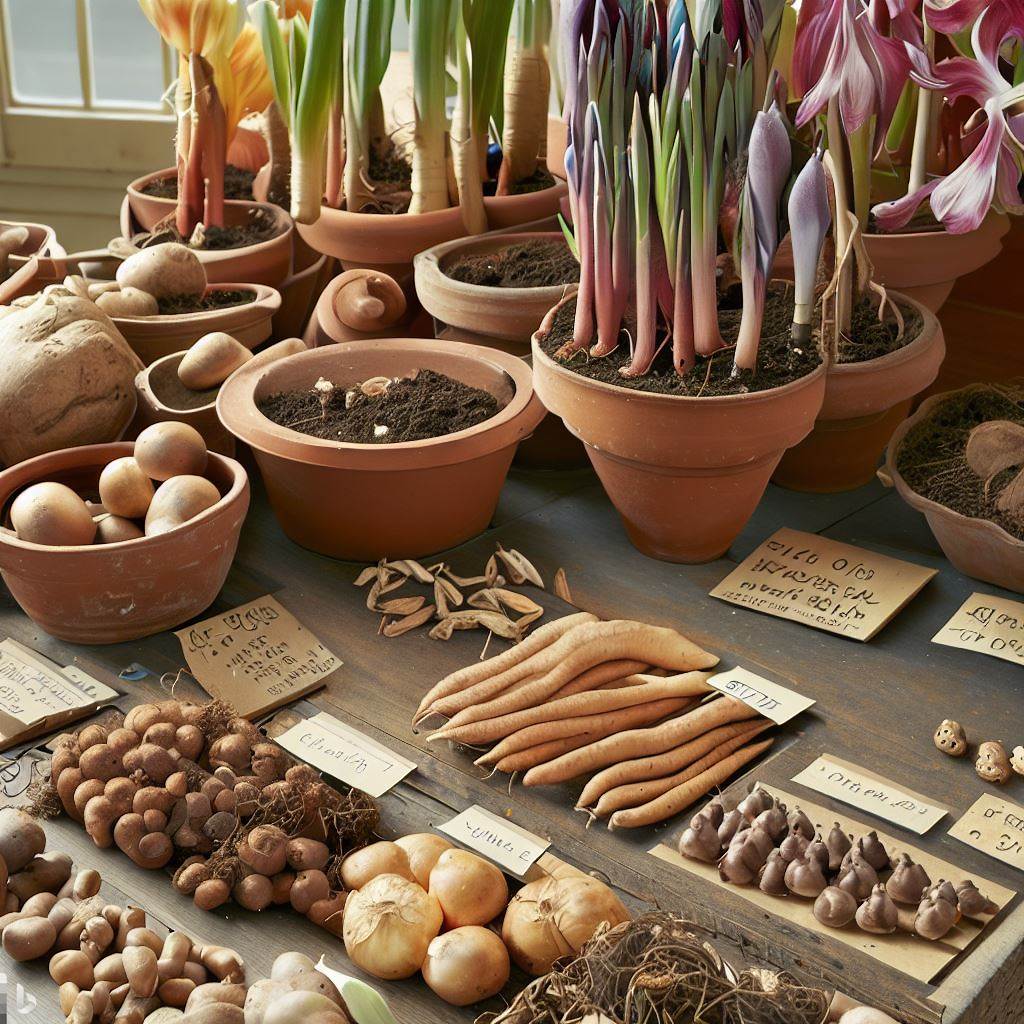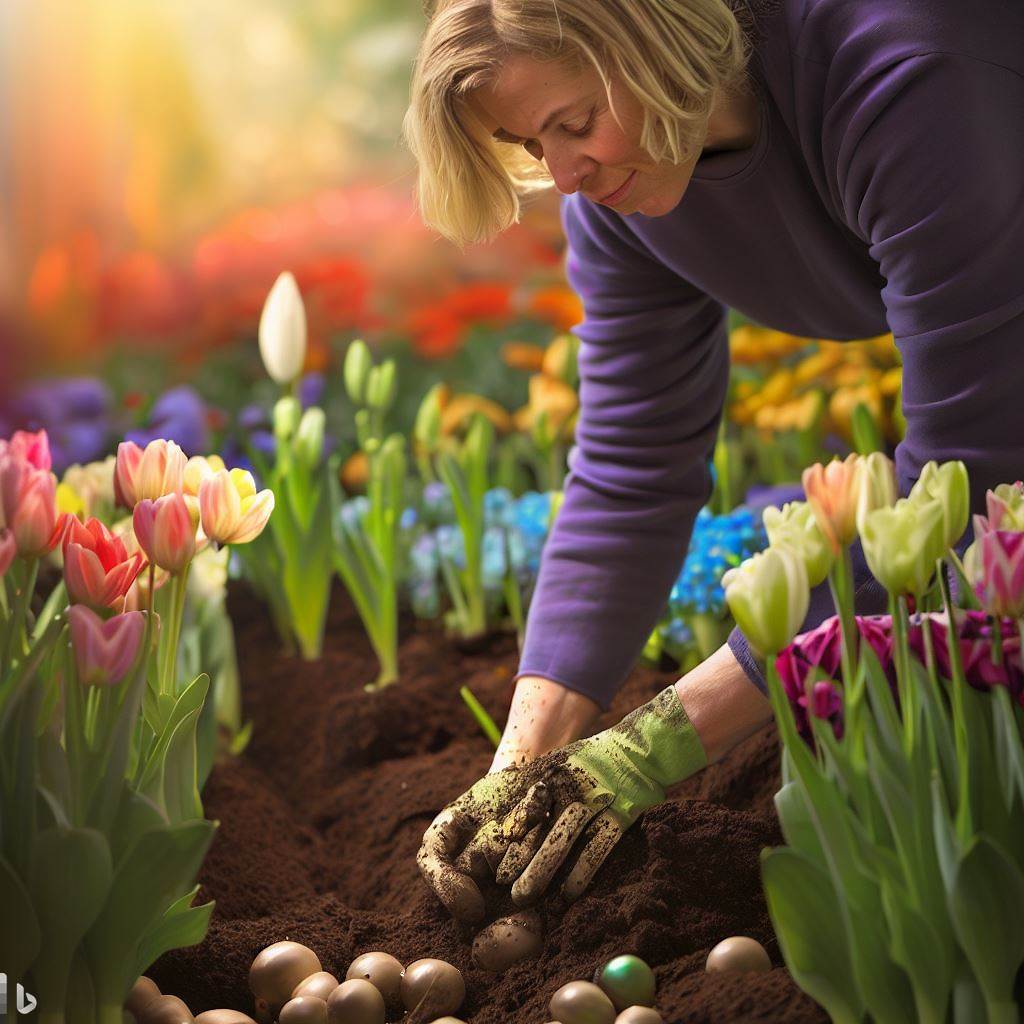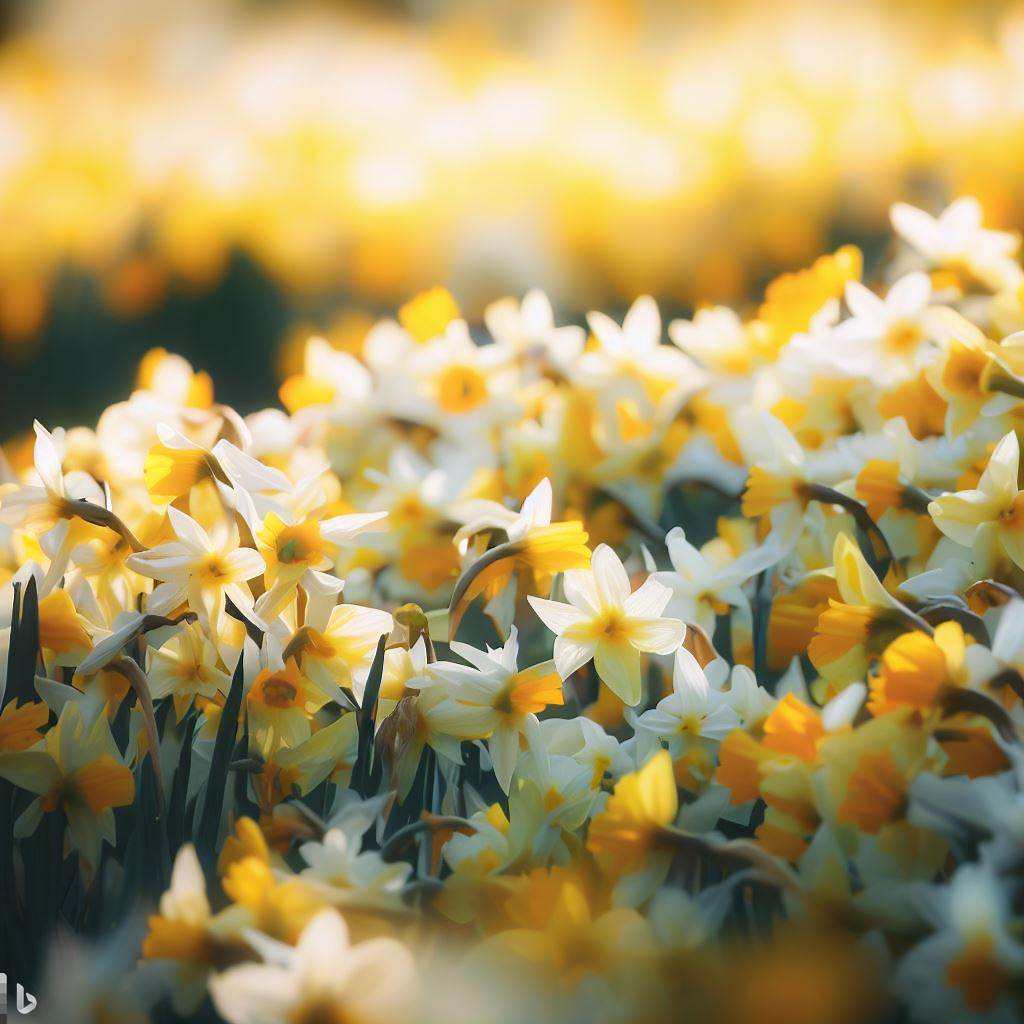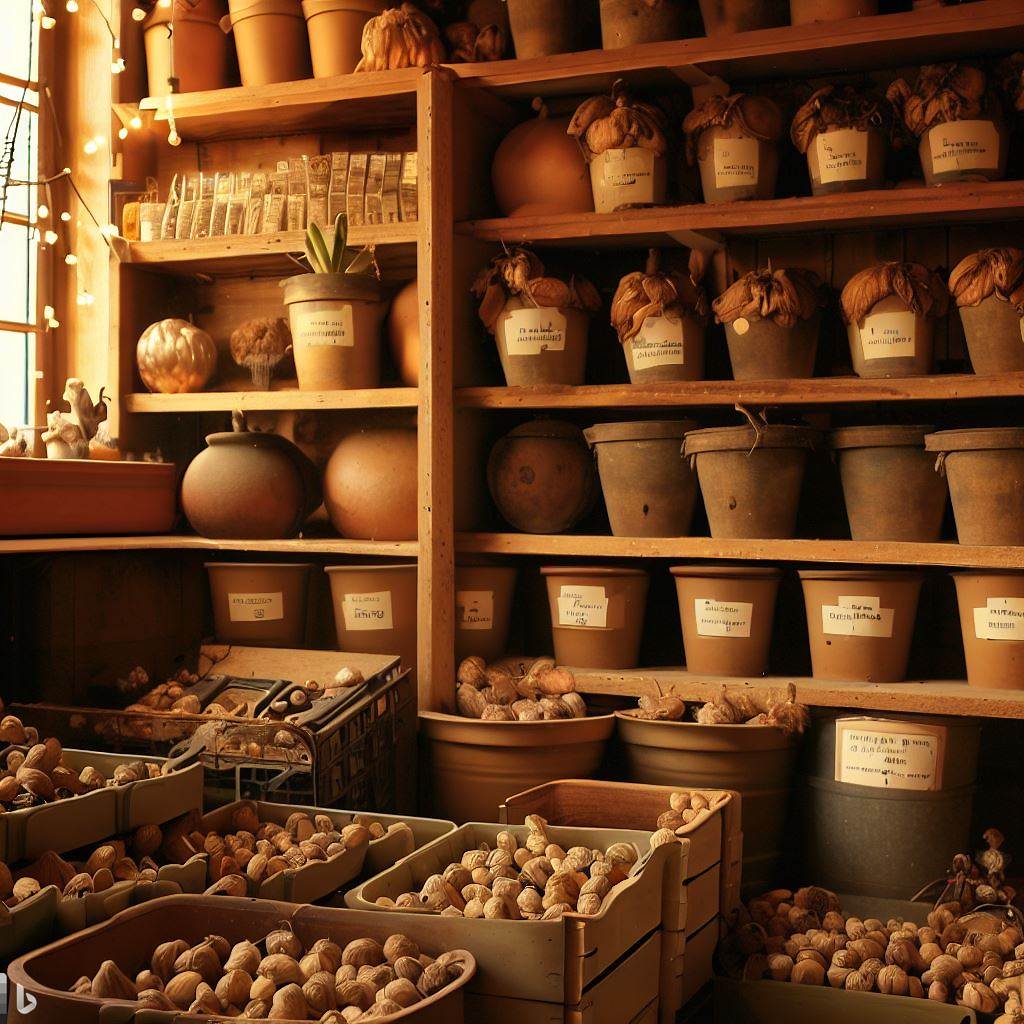Bulb flowers are the unsung heroes of our gardens. They’re like little treasure chests, packed with potential, waiting patiently under the soil to burst forth and transform our gardens into a riot of colors. From the early snowdrops of spring to the radiant dahlias of summer, common bulb flowers are the gift that keeps on giving.
They are also champions of biodiversity, attracting a host of beneficial insects to our gardens. Plus, they’re a joy to grow! There’s something truly magical about planting a bulb, nurturing it, and watching it bloom into a stunning flower.
Bulbs, Tubers, Corms and Rhyzomes – What is the Difference?
Corms, tubers, bulbs and rhizomes are all types of underground plant storage structures that help plants survive adverse conditions, such as winter or drought, and provide energy for growth and reproduction.
Bulbs, like tulips and daffodils, are layered structures that grow from the center out, with a basal plate on the bottom where roots grow, and a protective tunic on the outside. They contain a miniature plant inside and food stored in the fleshy scales.
Corms, found in plants like crocuses and gladioli, are similar to bulbs but are solid tissue inside, rather than layered. They have a basal plate and a tunic, and they grow a new corm on top of the old one each year.

Tubers, such as potatoes and dahlias, are swollen parts of the stem or root that store nutrients. They have buds or ‘eyes’ on the surface from which new plants can grow.
Rhizomes, like cannas and irises, are horizontal underground stems that send out roots on the underside and shoots to the surface. They grow horizontally and can spread quite extensively, creating new plants along their length.
Each of these structures has a unique way of ensuring the survival and propagation of the plants they belong to, making them a fascinating aspect of plant biology.
Most Common Bulb Flowers
We’ve included bulbs, tubers, rhizomes and corms in the list below for completeness, but here are the most common popular bulbs flowers that you will find…
 | Agapanthus (Agapanthus africanus) (Rhizome) Agapanthus, also known as lily of the Nile, are known for their large clusters of blue or white flowers. They prefer full sun and well-drained soil. Agapanthus bloom in the summer and are a great way to add a touch of the tropics to your garden. |
 | Allium (Allium giganteum) (Bulb) Alliums are admired for their globe-shaped clusters of flowers on tall stems. They prefer full sun and well-drained soil. Alliums bloom in late spring to early summer and are a great way to add height and drama to your garden. |
 | Amaryllis (Hippeastrum ‘Blossom Peacock’) (Bulb) Amaryllis are known for their large, trumpet-shaped flowers. They prefer bright, indirect light and bloom in the winter, making them a popular choice for indoor holiday decorations. |
 | Anemone (Anemone coronaria) (Tuber) Anemones are admired for their poppy-like flowers. They prefer partial shade and well-drained soil. Depending on the variety, anemones can bloom in spring or fall. |
 | Canna (Canna indica) (Rhizome) Cannas are known for their large, tropical-looking leaves and vibrant flowers. They prefer full sun and moist soil. Cannas bloom from late spring until frost and add a tropical touch to any garden. |
 | Caladium (Caladium bicolor) (Tuber) Caladiums are loved for their large, heart-shaped leaves in a variety of colors. They prefer partial to full shade and well-drained soil. While caladiums don’t have showy flowers, their colorful foliage provides interest from spring until frost. |
 | Calla Lily (Zantedeschia aethiopica) (Rhizome) Calla lilies are admired for their elegant, trumpet-shaped flowers. They prefer full sun to partial shade and moist, well-drained soil. Calla lilies bloom in late spring to early summer and are often used in wedding bouquets. |
 | Camas (Camassia leichtlinii) (Bulb) Camas are admired for their tall spikes of star-shaped flowers. They prefer full sun and moist soil. Camas bloom in late spring to early summer and are a great choice for a meadow or naturalized garden. |
 | Common Hyacinth (Hyacinthus orientalis) (Bulb) Hyacinths are known for their intoxicating fragrance and clusters of star-shaped flowers. They prefer full sun and well-drained soil, blooming in early spring. Their vibrant colors range from pink to blue to white. |
 | Coppertips (Freesia laxa) (Corm) Coppertips, also known as flame lilies, are admired for their bright red flowers. They prefer full sun and well-drained soil. Coppertips bloom in the spring and are a great way to add a pop of color to your garden. |
 | Crocus (Crocus sativus) (Corm) Crocus are known for their cup-shaped flowers that bloom in a variety of colors. They prefer full sun to partial shade and well-drained soil. Crocus are one of the first flowers to bloom in the spring, often while there’s still snow on the ground. |
 | Cyclamen (Cyclamen persicum) (Tuber) Cyclamens are known for their unique, upside-down flowers and heart-shaped leaves. They prefer partial shade and well-drained soil. Depending on the variety, cyclamens can bloom in fall, winter, or spring. |
 | Dahlia (Dahlia pinnata) (Tuber) Dahlias are loved for their large, vibrant flowers. They prefer full sun and well-drained soil. Dahlias bloom from midsummer to first frost, providing color in the garden when many other plants have finished blooming. |
 | Daffodil (Narcissus ‘Tete-a-Tete’) (Bulb) These cheerful yellow flowers are a sign that spring has arrived. Daffodils prefer full sun to partial shade and well-drained soil. They bloom in the early spring and are known for their resilience against pests. |
 | Freesia (Freesia refracta) (Corm) Freesias are loved for their fragrant, funnel-shaped flowers. They prefer full sun and well-drained soil. Freesias bloom in the spring and are often used in bouquets and floral arrangements. |
 | Fritillaries (Fritillaria meleagris) (Bulb) Fritillaries are admired for their checkered, bell-shaped flowers. They prefer full sun to partial shade and well-drained soil. Fritillaries bloom in the spring and are a unique addition to any garden. |
 | Gladiolus (Gladiolus hortulanus) (Corm) Gladiolus are known for their tall spikes of brightly colored flowers. They prefer full sun and well-drained soil. Gladiolus bloom in mid to late summer, making them a great choice for summer color. |
 | Grape Hyacinth (Muscari armeniacum) (Bulb) These petite, blue flowers resemble clusters of grapes, hence the name. They thrive in full sun to partial shade and bloom in mid-spring. Grape hyacinths are perfect for borders or underplanting taller bulbs. |
 | Lily (Lilium ‘Summer Night’ and Lilium martagon) (Bulb) Lilies are beloved for their large, fragrant flowers. They prefer full sun to partial shade and well-drained soil. Depending on the variety, lilies can bloom from late spring to late summer. |
 | Persian Lily (Fritillaria persica) (Bulb) Persian lilies are striking with their tall spikes of bell-shaped flowers. They prefer full sun to partial shade and well-drained soil. They bloom in mid to late spring and add a dramatic touch to any garden. |
 | Siberian Squill (Scilla siberica) (Bulb) Siberian squill are known for their bell-shaped, blue flowers. They prefer full sun to partial shade and well-drained soil. Siberian squill bloom in early spring, often while there’s still snow on the ground. |
 | Snowdrop (Galanthus nivalis and Galanthus elwesii) (Bulb) Snowdrops are one of the first flowers to bloom in the spring, often pushing through the snow. They prefer partial shade and well-drained soil. Their delicate, white flowers are a welcome sign of spring. |
 | Spanish Bluebell (Hyacinthoides hispanica) (Bulb) Spanish bluebells are known for their bell-shaped flowers in shades of blue, pink, or white. They thrive in partial shade and bloom in late spring. They’re a great choice for naturalizing in woodland gardens. |
 | Tulips (Tulipa) (Bulb) Tulips are a classic choice for any garden, known for their bold colors and elegant shape. They thrive in full sun and well-drained soil, blooming in the spring. With over 3,000 varieties, there’s a tulip for every garden design. |
 | Winter Aconite (Eranthis hyemalis) (Tuber) Winter aconite are known for their bright yellow flowers that bloom in the late winter or early spring. They prefer partial shade and well-drained soil. Winter aconite are one of the first flowers to bloom in the year. |
Keep in mind that these are only the most popular flowers that have a bulb, there are too many to mention them all in this article, but half the fun is in the discovery.
Understanding Common Bulb Flowers
In the simplest terms, a bulb is a plant that stores its entire life cycle in an underground storage structure. The bulb is a self-contained little powerhouse that holds everything the plant needs to grow and bloom.
Think of bulb flowers as nature’s version of a time capsule. They’re packed with nutrients and energy, ready to spring into action when the conditions are just right.
Some bulb flowers have the ability to multiply, creating new bulbs, or ‘offsets’, around the original bulb. It’s their way of ensuring their survival and spreading their beauty around your garden.
🌼 Bulb Basics: If you notice your bulb flowers becoming overcrowded or blooming less, it might be time to divide and replant the bulbs. This will give them more space to grow and keep your garden looking vibrant. 🌼
Caring for Bulb Flowers
Growing bulb flowers can be a rewarding experience, especially when you see those first shoots of green poking through the soil after a long winter. Here’s some hints on how to care for these plants to ensure they bloom year after year.
Planting Bulb Flowers
Planting bulb flowers is a relatively straightforward process, but there are a few key steps to remember:
- Choose the Right Time: Most bulb flowers are planted in the fall, before the first frost. This gives them a chance to establish roots before the cold winter months. However, some bulbs, like dahlias and canna lilies, are planted in the spring.
- Select the Right Spot: Most bulb flowers prefer a spot with full sun and well-drained soil. However, some, like cyclamen and Spanish bluebells, do well in partial shade.
🌼 Bulb Basics: Rotate bulb plantings yearly to prevent disease build-up in the soil. 🌼
- Plant Correctly: As a general rule, bulbs should be planted at a depth three times their height. The pointy end should face up. If in doubt, plant the bulb on its side; the plant will find its way up.

Maintaining and Caring for Bulb Flowers
Once your bulbs are in the ground, ongoing care is relatively minimal:
- Watering: After planting, water your bulbs thoroughly. During their growth and bloom periods, keep the soil evenly moist but not waterlogged.
- Fertilizing: A slow-release bulb fertilizer can be beneficial at planting time. Another application of fertilizer when the shoots first appear in spring can also be beneficial.
- Mulching: A layer of mulch can help protect the bulbs from extreme temperatures and retain soil moisture.
🌼 Bulb Basics: Deadhead spent flowers to direct energy back into the bulb. 🌼
Addressing Common Problems
Like all plants, bulb flowers can encounter problems:
- Pests: Some bulbs, especially tulips and lilies, can be attractive to pests like slugs and snails. Use environmentally friendly pest control methods to keep these critters at bay.
- Diseases: Bulb rot is a common issue if bulbs are planted in areas with poor drainage. Ensure your bulbs are planted in well-draining soil to prevent this.
- Overcrowding: Over time, some bulbs, like daffodils, can become overcrowded and may need to be divided. This is typically done after the flowers have bloomed and the foliage has died back.

How to Get Rid of Bulb Flowers
If you need to remove bulb flowers, perhaps because they’ve become invasive or you’re changing your garden design, the best method is to dig them up. Wait until the foliage has died back, then carefully dig around the bulb, lift it out, and dispose of it. Remember, some bulbs can be toxic, so wear gloves and avoid ingesting any part of the plant.
Caring for bulb flowers doesn’t have to be complicated. With a little knowledge and care, you can enjoy these beautiful blooms year after year. Happy gardening!
Digging Up and Storing Bulbs: Why, How, and When
Bulb flowers are a gift that keeps on giving. But to ensure their longevity and health, sometimes we need to intervene. That’s where digging up and storing bulbs come into play.
Why Dig Up and Store Bulbs?
Not all of the common bulb flowers are created equal. Some, like daffodils and tulips, can be left in the ground year-round in many climates. Others, particularly tender bulbs like dahlias and gladiolus, may not survive cold winter temperatures and need to be dug up and stored indoors until the next growing season.
Digging up and storing bulbs can also help control diseases and pests, rejuvenate overcrowded beds, and allow you to move or share plants.

How to Dig Up and Store Bulbs?
Here’s a step-by-step guide:
- Wait for the right time. This is usually after the foliage has died back, but before the first hard frost. The foliage stores energy for the next growing season, so it’s important to let it die back naturally.
- Dig carefully. Use a garden fork or spade to loosen the soil around the bulbs, being careful not to damage them. Lift the bulbs out of the ground.
- Clean and dry. Brush off loose soil and let the bulbs dry for a few days in a well-ventilated area away from direct sunlight.
- Inspect and discard. Discard any bulbs that are diseased or damaged. Healthy bulbs should be firm and free of spots or mold.
- Store properly. Place the bulbs in a single layer in a tray or shallow box. Store them in a cool, dry place over the winter. Some bulbs, like dahlias and cannas, may need to be stored in slightly moist peat moss or sand to prevent them from drying out.
When to Replant?
Replant your bulbs in the spring after the threat of frost has passed. If you’re unsure of the right planting depth or spacing, a general rule of thumb is to plant the bulb two to three times as deep as the bulb is tall, and space bulbs approximately three times the bulb’s width apart.
Each bulb flower has its own specific needs, so it’s always a good idea to do a bit of research on the specific variety you’re planting. With a little care and attention, your bulb flowers can provide you with many seasons of beauty.
